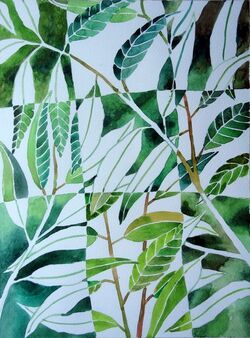Supplies needed:
- watercolor paper size:
- watercolor brushes, round and flat various sizes
- watercolor, crayola is decent for learning however winsor and newton has the best, a small pallett can be found online at amazon
- a water bowl
- paper towels

You will take several photos on a white background arranged in various positions.
On the watercolor paper you will draw out the photo you took. Section the paper into six squares. 3 squares will be painted in the negative space, the other 3 squares will be painted in the positive.
No so if you go negative, positive, negative on the first row, the second row will be positive, negative, positive.
On the watercolor paper you will draw out the photo you took. Section the paper into six squares. 3 squares will be painted in the negative space, the other 3 squares will be painted in the positive.
No so if you go negative, positive, negative on the first row, the second row will be positive, negative, positive.
Grading Rubric:
- 20pts Picture is taken by you, not from the internet or a magazine
- 20pts A flat wash is apparent
- 20pts No streaks
- 20pts watercolor is translucent and not applied thickly
- 20pts Craftsmanship, work is not sloppy, complete and created with intent.
Essential question: What properties does watercolor have over other mediums.
How will we know if they’ve learned it?
Students will have a painting of various botanical photos composed of the various techniques learned from the previous intro lesson.
What will we do if they don’t learn it?
Students will be re-taught and can utilized videos to re-work missing elements of their assignment.
What will we do if they have / have already learned?
Students can always go above and beyond the instructions to create a more challenging experience.
My students understand and can… by the end of the lesson
Have the knowledge and skills to move to the next assignment
Teks: 117.C (Knowledge and skills) (B) identify and understand the elements of art, including line, shape, color, texture, form, space, and value, as the fundamentals of art in personal artwork; (C) identify and understand the principles of design, including emphasis, repetition/pattern, movement/rhythm, contrast/variety, balance, proportion, and unity, in personal artwork; (B) identify and understand the elements of art, including line, shape, color, texture, form, space, and value, as the fundamentals of art in personal artwork; (C) identify and understand the principles of design, including emphasis, repetition/pattern, movement/rhythm, contrast/variety, balance, proportion, and unity, in personal artwork,
How will we know if they’ve learned it?
Students will have a painting of various botanical photos composed of the various techniques learned from the previous intro lesson.
What will we do if they don’t learn it?
Students will be re-taught and can utilized videos to re-work missing elements of their assignment.
What will we do if they have / have already learned?
Students can always go above and beyond the instructions to create a more challenging experience.
My students understand and can… by the end of the lesson
Have the knowledge and skills to move to the next assignment
Teks: 117.C (Knowledge and skills) (B) identify and understand the elements of art, including line, shape, color, texture, form, space, and value, as the fundamentals of art in personal artwork; (C) identify and understand the principles of design, including emphasis, repetition/pattern, movement/rhythm, contrast/variety, balance, proportion, and unity, in personal artwork; (B) identify and understand the elements of art, including line, shape, color, texture, form, space, and value, as the fundamentals of art in personal artwork; (C) identify and understand the principles of design, including emphasis, repetition/pattern, movement/rhythm, contrast/variety, balance, proportion, and unity, in personal artwork,
